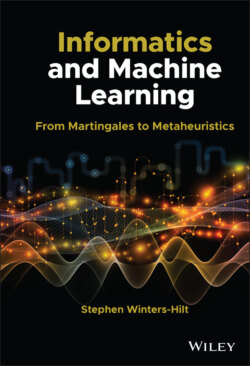Читать книгу Informatics and Machine Learning - Stephen Winters-Hilt - Страница 2
Table of Contents
Оглавление1 Cover
2 Title Page
3 Copyright Page
4 Dedication Page
5 Preface
6 1 Introduction 1.1 Data Science: Statistics, Probability, Calculus … Python (or Perl) and Linux 1.2 Informatics and Data Analytics 1.3 FSA‐Based Signal Acquisition and Bioinformatics 1.4 Feature Extraction and Language Analytics 1.5 Feature Extraction and Gene Structure Identification 1.6 Theoretical Foundations for Learning 1.7 Classification and Clustering 1.8 Search 1.9 Stochastic Sequential Analysis (SSA) Protocol (Deep Learning Without NNs) 1.10 Deep Learning using Neural Nets 1.11 Mathematical Specifics and Computational Implementations
7 2 Probabilistic Reasoning and Bioinformatics 2.1 Python Shell Scripting 2.2 Counting, the Enumeration Problem, and Statistics 2.3 From Counts to Frequencies to Probabilities 2.4 Identifying Emergent/Convergent Statistics and Anomalous Statistics 2.5 Statistics, Conditional Probability, and Bayes' Rule 2.6 Emergent Distributions and Series 2.7 Exercises
8 3 Information Entropy and Statistical Measures 3.1 Shannon Entropy, Relative Entropy, Maxent, Mutual Information 3.2 Codon Discovery from Mutual Information Anomaly 3.3 ORF Discovery from Long‐Tail Distribution Anomaly 3.4 Sequential Processes and Markov Models 3.5 Exercises
9 4 Ad Hoc, Ab Initio, and Bootstrap Signal Acquisition Methods 4.1 Signal Acquisition, or Scanning, at Linear Order Time‐Complexity 4.2 Genome Analytics: The Gene‐Finder 4.3 Objective Performance Evaluation: Sensitivity and Specificity 4.4 Signal Analytics: The Time‐Domain Finite State Automaton (tFSA) 4.5 Signal Statistics (Fast): Mean, Variance, and Boxcar Filter 4.6 Signal Spectrum: Nyquist Criterion, Gabor Limit, Power Spectrum 4.7 Exercises
10 5 Text Analytics 5.1 Words 5.2 Phrases – Short (Three Words) 5.3 Phrases – Long (A Line or Sentence) 5.4 Exercises
11 6 Analysis of Sequential Data Using HMMs 6.1 Hidden Markov Models (HMMs) 6.2 Graphical Models for Markov Models and Hidden Markov Models 6.3 Standard HMM Weaknesses and their GHMM Fixes 6.4 Generalized HMMs (GHMMs – “Gems”): Minor Viterbi Variants 6.5 HMM Implementation for Viterbi (in C and Perl) 6.6 Exercises
12 7 Generalized HMMs (GHMMs) 7.1 GHMMs: Maximal Clique for Viterbi and Baum–Welch 7.2 GHMMs: Full Duration Model 7.3 GHMMs: Linear Memory Baum–Welch Algorithm 7.4 GHMMs: Distributable Viterbi and Baum–Welch Algorithms 7.5 Martingales and the Feasibility of Statistical Learning (further details in Appendix) 7.6 Exercises
13 8 Neuromanifolds and the Uniqueness of Relative Entropy 8.1 Overview 8.2 Review of Differential Geometry [206, 207] 8.3 Amari’s Dually Flat Formulation [113–115] 8.4 Neuromanifolds [113–115] 8.5 Exercises
14 9 Neural Net Learning and Loss Bounds Analysis 9.1 Brief Introduction to Neural Nets (NNs) 9.2 Variational Learning Formalism and Use in Loss Bounds Analysis 9.3 The “sinh−1(ω)” link algorithm (SA) 9.4 The Loss Bounds Analysis for sinh−1(ω) 9.5 Exercises
15 10 Classification and Clustering 10.1 The SVM Classifier – An Overview 10.2 Introduction to Classification and Clustering 10.3 Lagrangian Optimization and Structural Risk Minimization (SRM) 10.4 SVM Binary Classifier Implementation 10.5 Kernel Selection and Tuning Metaheuristics 10.6 SVM Multiclass from Decision Tree with SVM Binary Classifiers 10.7 SVM Multiclass Classifier Derivation (Multiple Decision Surface) 10.8 SVM Clustering 10.9 Exercises
16 11 Search Metaheuristics 11.1 Trajectory‐Based Search Metaheuristics 11.2 Population‐Based Search Metaheuristics 11.3 Exercises
17 12 Stochastic Sequential Analysis (SSA) 12.1 HMM and FSA‐Based Methods for Signal Acquisition and Feature Extraction 12.2 The Stochastic Sequential Analysis (SSA) Protocol 12.3 Channel Current Cheminformatics (CCC) Implementation of the Stochastic Sequential Analysis (SSA) Protocol 12.4 SCW for Detector Sensitivity Boosting 12.5 SSA for Deep Learning 12.6 Exercises
18 13 Deep Learning Tools – TensorFlow 13.1 Neural Nets Review 13.2 TensorFlow from Google 13.3 Exercises
19 14 Nanopore Detection – A Case Study 14.1 Standard Apparatus 14.2 Controlling Nanopore Noise Sources and Choice of Aperture 14.3 Length Resolution of Individual DNA Hairpins 14.4 Detection of Single Nucleotide Differences (Large Changes in Structure) 14.5 Blockade Mechanism for 9bphp 14.6 Conformational Kinetics on Model Biomolecules 14.7 Channel Current Cheminformatics 14.8 Channel‐Based Detection Mechanisms 14.9 The NTD Nanoscope 14.10 NTD Biosensing Methods 14.11 Exercises
20 Appendix A: Python and Perl System Programming in Linux A.1 Getting Linux and Python in a Flash (Drive) A.2 Linux and the Command Shell A.3 Perl Review: I/O, Primitives, String Handling, Regex
21 Appendix B: Physics B.1 The Calculus of Variations
22 Appendix C: Math C.1 Martingales [102] C.2 Hoeffding Inequality
23 References
24 Index
25 End User License Agreement
